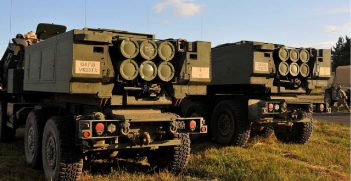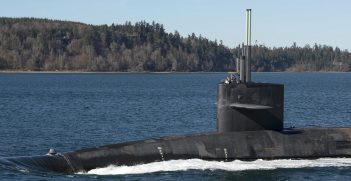Ocean Transparency and Australia’s Impact on Nuclear Stability

The establishment of AUKUS was another milestone in Australia’s development of a comprehensive maritime defence strategy. However, the advancement of anti-submarine warfare (ASW) capabilities threatens nuclear stability in the Indo-Pacific.
Building upon the Royal Australian Navy’s Future Frigate Program, the AUKUS agreement allows for the sharing of critical breakthroughs in military applications of artificial intelligence and quantum technology – both with the potential to significantly advance Australia’s anti-submarine capability. While ASW capabilities will serve Australia’s short-term strategic interests in defending against Chinese maritime aggression, it marginalises the importance of submarines for nuclear stability. At this crossroads in the direction of Australian defence, policymakers should set aside the immediate benefits of developing such capabilities, and consider the future pressure advanced ASW capabilities will place on stability in the face of nuclear warfare.
Nuclear Stability at Sea
Understanding the importance of nuclear-armed submarines (SSBNs), or strategic submarines, first requires an understanding of how strategic stability is maintained. Strategic stability is a state of nuclear stability where there are no incentives for states to engage in an arms race and no incentives for states to deliberately escalate crises to gain an upper hand.
Under the auspices of mutually assured destruction, strategic stability is maintained due to the idea that no matter what, launching a nuclear first strike will result in the retaliatory annihilation of the attacking state. In order to ensure that there are no incentives to launch a nuclear assault or engage in arms racing, all nuclear-armed states should have total confidence in their nuclear second-strike capacity. At the most basic level, this requires secure warhead containment and transport, and robust nuclear command, control, and communication.
Alongside the continued advancement of nuclear arsenals, states have sought the development of strategic non-nuclear weapons (SNNWs) to counter and destroy an enemy’s nuclear arsenal. In recent decades, however, the rapid development of these weapons has damaged nuclear-armed states’ confidence in their ability to retaliate following a nuclear attack. Because of the advancement of weapons systems such as ballistic missile defence, anti-satellite, and anti-submarine technologies, nuclear-armed states may have more of an incentive to arms race.
Strategic submarines play an essential and unique role in upholding strategic stability. In comparison to the land and air components of the nuclear triad, strategic submarines are incredibly hard to track and monitor due to the complexity, depth, and vastness of the earth’s oceans. Since their inception, SSBNs have been heralded as the last bastion of defence for a state’s nuclear arsenal because of their concealability: if all else fails in the event of a nuclear attack, a state will always have a retaliatory capacity due to their hidden submarines. However, the advancement of ASW capabilities threaten to undermine this confidence, and can disturb nuclear stability.
AUKUS and Anti-Submarine Technology
Among the plethora of defence technologies which AUKUS may bring to the table for Australia, the potential to enhance Australia’s ASW capabilities may end up being problematic for nuclear stability. Although there has been no explicit announcement of an anti-submarine project, Australia has indicated a focus on ASW in its future acquisition projects. The acquisition of nuclear-powered submarines, Hunter-class frigates, and statements on ASW in the Australian Defence 2020 Force Structure Plan show a focus on deterring and defending against Chinese maritime assertiveness through ASW.
With the increased focus on critical technologies such as AI and quantum computing, further breakthroughs in ASW technologies are likely. For example, the current development of AI and sensor technology for ocean monitoring, as well as advancements in underwater communications, will likely assist in making the ocean “transparent” by 2050. This is highly concerning, as gaining the ability to track and surveil strategic submarines will significantly reduce confidence in nuclear-armed states’ second-strike capability.
The pursuit of this technological advancement for hunting nuclear-armed submarines will have considerable implications for AUKUS in the form of technology transfer. In 2016, the US renewed the Cold War-era Sound Surveillance System (SOSUS). Although SOSUS proved ineffective during the Cold War, a suite of emerging technologies such as AI, quantum technology, and underwater drones have increased the effectiveness of hunting and tracking nuclear-armed submarines.
For Australia, the information and technology transfer agreement underpinning AUKUS will likely lead to the Royal Australian Navy acquiring similar ASW technologies for future programs, such as the anti-submarine-focused Future Frigate Program. With this technology from the US and the continued focus on ASW, Australia will likely control a formidable suite of anti-submarine technologies capable of hunting out and tracking Chinese and Russian SSBNs. Although this may serve Australia’s short-term maritime defence aspirations, it also brings looming complications for regional nuclear stability.
The Irony of Embracing Destruction – Protecting Nuclear-Weapons
In order to protect regional nuclear stability in the coming years, the impacts of new defence technologies must be carefully considered. Though they provide new capability and contribute to Australia’s maritime deterrent, the development of maritime counterforce measures such as sound surveillance and passive acoustic monitoring may undermine strategic stability. Although it may be ironic to support nuclear arsenals in order to protect against nuclear war, maintaining Russian and Chinese confidence in the safety of their nuclear weapons will reduce incentives to launch a first-strike against the US or its regional allies.
For Australia, taking into consideration the destructive potential of advanced ASW capabilities may help maintain this nuclear stability. Rather than developing an ASW capability robust enough to make the oceans transparent, there are clear benefits in allowing adversaries’ submarines to operate in a level of secrecy. Although this may not suit Australia’s short-term defence objective of deterring China, it may benefit the longer-term strategic interest of maintaining nuclear stability.
Ben Yeldham is a postgraduate student in strategic studies at the Australian National University’s Strategic and Defence Studies Centre. His research focuses on strategic weaponry and nuclear stability. Ben is a former intern for the AIIA National Office.
This article is published under a Creative Commons License and may be republished with attribution.





